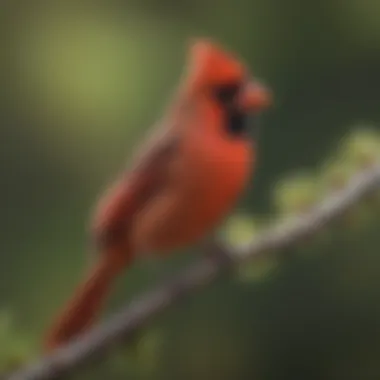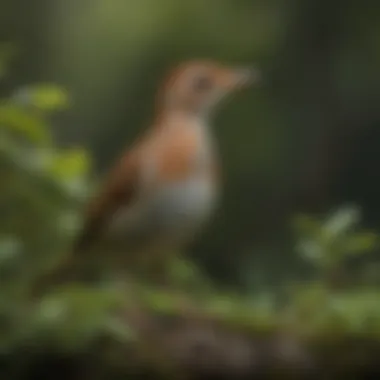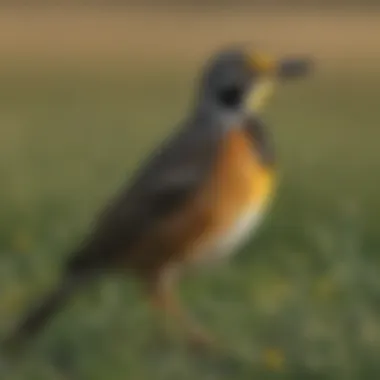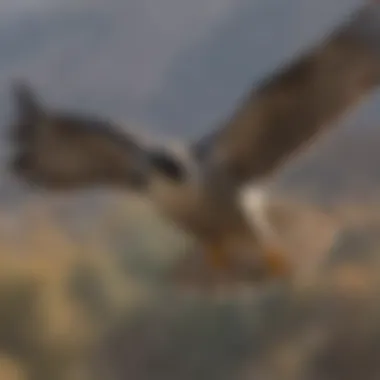Exploring Missouri Bird Calls: A Guide to Avian Sounds


Intro
Missouri, often referred to as the Show-Me State, serves as a vibrant backdrop for a rich tapestry of avian life. In this region, bird calls echo through forests, wetlands, and prairies, each one a unique expression of the diverse species that inhabit these landscapes. Understanding these calls not only enhances the experience for birdwatchers but also offers insights into the ecological health of the area. This article will uncover the complexity of bird sounds you may encounter while leisurely walking through Missouri's natural spaces.
Fascinating Facts About the Animal
Unique Characteristics
Missouri is home to a variety of bird species, each possessing unique characteristics that define their calls. For instance, the Eastern Meadowlark's distinctive two-part whistle is designed for long-distance communication. This melody often signifies territory and can be heard during mating rituals.
Extraordinary Abilities
Birds like the American Robin exhibit exceptional listening skills. They can differentiate between subtle variations in pitch and rhythm, allowing them to interpret not just their own calls but also those of others. This ability plays a pivotal role in their survival and social interactions.
Behavior and Habitat
Natural Habitats
Missouri’s diverse habitats, including forests, grasslands, wetlands, and urban environments, influence the variety of bird calls. Each habitat supports distinct bird communities that have adapted to thrive within these settings.
Social Structures
Birds within these habitats often form intricate social structures. For example, American Crow families typically consist of a mated pair and their offspring, working collaboratively to defend their territory and raise the next generation. Their calls serve as a means of communication among family members, especially in alerting them to potential threats.
Recent Scientific Discoveries
Latest Research Findings
Recent studies have demonstrated how environmental changes affect bird calls in Missouri. For instance, research indicates that urban noise pollution significantly alters the pitch and timing of calls, impacting communication among various species. This phenomenon has important implications for urban wildlife management.
Breakthroughs in Animal Biology
Scientists have made breakthroughs in understanding how birds learn and modify their calls. It's noted that younger birds often mimic calls from older, experienced individuals. This learning process is crucial for their integration into social groups and survival strategies.
Cultural Significance
Animals in Folklore
In Missouri folklore, certain birds like the Cardinal hold significant cultural meaning. The Cardinal, often seen as a symbol of hope and renewal, is frequently depicted in local stories and artwork.
Influence on Art and Literature
Bird calls and sightings have influenced various artists and writers, inspiring works that reflect the beauty and complexity of nature. Local poets may refer to the melodic call of the Whip-poor-will, drawing connections to themes of solitude and reflection in their verses.
Understanding bird calls enriches our connection with the natural world, offering a glimpse into the lives of these remarkable creatures.
This exploration into Missouri bird calls not only enhances the birdwatching experience but also contributes to a deeper appreciation of the delicate balance within ecosystems. Insight into these avian communications can inspire conservation efforts and foster a sense of responsibility toward protecting the natural habitats we often take for granted.
Prologue to Bird Calls
Bird calls serve as a critical component of avian communication. In this article, we explore their multifaceted roles and significance, particularly in the context of Missouri's diverse bird species. Understanding bird calls enhances one’s ability to appreciate nature and fosters a deeper connection with the environment. For enthusiasts, recognizing these sounds can lead to more rewarding birdwatching experiences. Additionally, studying bird calls contributes to science and conservation efforts, emphasizing the need for continued research and awareness.
Defining Bird Calls
Bird calls are the vocalizations made by birds, used for various purposes. These sounds are crucial for communication, helping birds convey messages to one another. Calls can range from simple notes to complex sequences, often varying widely by species. A fundamental distinction exists between songs and calls; songs are typically longer and more melodious, often associated with mating rituals. In contrast, calls are shorter and serve a multitude of functions, such as alerting others to danger or maintaining contact with a flock. The ability to understand these differences is essential for both casual observers and researchers.
The Role of Bird Calls in Ecosystems
Bird calls play significant roles in maintaining ecological balance. They contribute to the social dynamics within avian communities, facilitating interactions that are vital for survival. For instance, alarm calls can warn others about predators, ensuring the safety of the group. Furthermore, mating calls help ensure genetic diversity by attracting mates from different populations.


Moreover, bird calls impact the ecosystem by influencing the behavior of other species, both avian and non-avian. These interactions can affect predator-prey relationships, plant pollination, and seed dispersal. The intricate web of sounds and responses highlights the importance of avian vocalizations within Missouri's ecosystems. This connection underlines how bird calls are not merely sounds, but integral parts of ecological processes.
"The song of a bird is not just a melody; it represents a narrative of survival, communication, and adaptation."
In summary, bird calls are vital not only for the individual birds but also for the broader ecosystem. Understanding their definitions and roles enriches our overall perspective on natural environments.
Missouri, with its rich avian diversity, offers an ideal backdrop for studying these captivating sounds.
The Diversity of Missouri's Bird Species
Missouri hosts a rich tapestry of bird species, making it a vital region for ornithological study and appreciation. The presence of various avian species reflects not only the state's ecological diversity but also its varied habitats. This section will illuminate the significance of recognizing and understanding these species, both for the environmental health of the region and for the appreciation of birdwatchers and casual observers alike. Acknowledging the diversity of Missouri's bird population allows enthusiasts to grasp the intricate relationships between species, their habitats, and the demands of their environments. The more we learn about them, the better we can appreciate their roles in the ecosystem.
Common Species Found in Missouri
Missouri’s landscape is home to a variety of bird species that are easily recognizable. These common birds serve as indicators of ecological health and enhance the enjoyment of birdwatching experiences.
American Robin
The American Robin is perhaps one of the most iconic birds in North America. Known for its bright orange breast, it signals the arrival of spring in Missouri. Its melodious song is often heard, contributing to the pleasant soundscape of neighborhoods and parks. The American Robin is beneficial for this article as it serves as a bridge between novice bird watchers and the avian world.
A unique feature of this bird is its ability to adapt to urban environments, making it a familiar sight even within cities. This adaptability allows them to thrive in various habitats, which is advantageous for those learning about bird calls. However, some may find their frequent presence somewhat monotonous.
Red-tailed Hawk
The Red-tailed Hawk is a skilled predator known for its keen eyesight and powerful build. It is prominently featured in the skies across Missouri, often seen soaring effortlessly on thermal currents. This magnificent bird contributes to the article by showcasing the predatory aspect of the bird community, vital for maintaining ecological balance.
This species is characterized by its distinctive red tail, which becomes more pronounced in adult birds. Observing a Red-tailed Hawk can enhance one's understanding of the more complex dynamics of Missouri's bird calls, especially during mating seasons when their shrill cries echo through the air. One potential disadvantage is that these hawks can be harder to spot due to their preference for high perches.
Eastern Bluebird
The Eastern Bluebird is a small songbird that brings beauty and color to Missouri's fields and open areas. Known for its sweet, cheerful song, the Eastern Bluebird captures the hearts of many bird watchers. Its presence in this article emphasizes the impact of songbirds in the avian soundscape.
One notable characteristic is its attractiveness, often being a sought-after species for nesting due to its striking colors. Their songs are easy to learn and identify, making them a popular subject for birdwatchers. However, they can be harshly affected by habitat loss, which poses a challenge for conservation efforts.
Song Sparrow
The Song Sparrow is another prevalent species known for its melodious call. Its varying vocalizations contribute to the ambient sounds found in wetland areas and gardens throughout Missouri. This bird's diversity in calls makes it an exciting species to study, especially for those interested in learning about regional sounds.
Characteristic for its streaked brown and white plumage, the Song Sparrow offers a delightful visual to match its auditory beauty. It stands out due to its adaptability to different habitats, from wetlands to urban areas. However, its tendency to blend into surroundings may pose challenges in identifying them in the wild.
Rare and Migratory Birds
Missouri is not only a home to common species but also a critical stopover for rare and migratory birds. Understanding these birds adds another layer to the ecological complexity represented in the state. Examples include species like the Bald Eagle and various shorebirds during migration seasons. These birds highlight the importance of monitoring migratory paths and behaviors, which are essential for conservation efforts.
Understanding the Vocalizations
Understanding the vocalizations of birds is a pivotal aspect of comprehending avian behavior. Each call and song serves a variety of functions that are crucial for survival and reproduction. Through this understanding, one can appreciate both the complexity of bird communication and the rich biodiversity present in Missouri's environment. Recognizing these vocalizations not only enhances the birdwatching experience but also fosters a connection towards conservation efforts and the appreciation of local ecosystems.
Types of Bird Calls
Songs
Songs of birds can be characterized as elaborate and melodious sounds typically produced by males during the breeding season. They play a significant role in attracting mates and establishing territory boundaries. The key characteristic of these songs is their complexity, often consisting of several phrases that can vary widely among species. This complexity makes songs a beneficial choice for our discussion, as they provide an opportunity to explore the acoustic diversity of birds in Missouri.
The unique feature of songs lies in their ability to evolve based on environmental factors and social interactions. This adaptability enhances their effectiveness but can also create challenges for species that must compete with each other to be heard.
Calls
Calls are shorter and simpler vocalizations that birds use regularly for communication purposes. Often, calls convey important information such as location or warnings. The key characteristic of calls is their brevity and consistency, which makes them a popular choice for both identification and research into bird behavior.
A unique feature of calls is their ability to vary slightly depending on context and urgency. While this flexibility allows birds to adjust their messages, it can also lead to miscommunication if not properly recognized by listeners.
Alarm Calls


Alarm calls serve a crucial purpose in alerting other birds to potential dangers, such as predators. These vocalizations are often loud and persistent, drawing immediate attention. The key characteristic of alarm calls is their urgency, prompting swift responses from nearby birds. This type of vocalization is beneficial as it enhances survival rates among flocks.
A unique feature of alarm calls is their variability in pitch and duration, depending on the threat level. Such variability can mislead predators but may also cause confusion within the bird population regarding the nature of the threat.
Contact Calls
Contact calls are typically used by birds to maintain communication with each other within a group or flock. These calls can be soft and subtle, emphasizing the need for consistent interaction among members. The key characteristic of contact calls is their continuity, making them a beneficial aspect of social bonding within species.
The unique feature of contact calls is their tendency to differ across different environments or situations. This adaptation can strengthen social structures, but overly simplified calls may not convey enough information in complex habitats.
Functions of Bird Calls
Mating
Mating calls are an essential part of a bird's reproductive strategy. They help attract females and indicate the male's fitness and vitality. The key characteristic of mating calls is their rich assortment of tones and patterns, making them a beneficial component of understanding breeding behavior.
A unique feature of mating calls is their correlation with environmental factors such as habitat and season. Changes in these elements can influence the effectiveness of mating calls and, consequently, breeding success.
Territorial Defense
Birds use vocalizations as a means of asserting dominance over their territory. These calls serve as a warning to intruders, indicating that a space is already claimed. The key characteristic of these calls is their loudness and aggression, establishing a beneficial barrier for potential competitors.
A unique feature of territorial calls is their variations in response to the presence of rivals, reflecting the dynamic nature of territorial disputes. This adaptability can enhance success in defending territory but may require significant energy from the calling bird.
Communication with Young
Communication with young birds is vital for their survival and development. Parent birds often use specific calls to teach their hatchlings about food sources and dangers. The key characteristic of these communicative interactions is their distinctiveness, making them a valuable aspect of parental care in the wild.
A unique feature of communication with young birds is the simplicity of the sounds used. These essential calls can be easily recognized, enabling young birds to respond effectively to their parents, though it can limit the complexity of messages exchanged as they grow.
Identifying Bird Calls in Missouri
Identifying bird calls in Missouri is a vital aspect of understanding avian life in the region. Bird calls are essential communication tools among birds. Being able to identify these calls can enhance the experience of both casual birdwatchers and serious ornithologists. Knowing the calls helps in locating birds, understanding their behavior, and even contributing to conservation efforts. Recognizing specific sounds opens the door to observing interactions in environments. It also allows one to appreciate the diversity and complexity of avian communication.
Sound Patterns and Characteristics
Different birds produce unique sound patterns and characteristics. These sounds are influenced by several factors including species, environment, and the purpose of the call. Bird songs tend to be more melodic and are primarily used during mating seasons. The songs can vary significantly between species. For example, the Eastern Bluebird produces a sweet, repeating song that is notably distinctive.
Other calls are less melodic and vary in tone and pitch. Alarm calls, for instance, are usually sharp and abrupt, intended to alert other birds of danger. From chirps to whistles, each sound carries specific meanings within the species' context.
Tools for Bird Call Identification
Identifying bird calls can be challenging, but several tools can make this process easier. Utilizing various resources allows for a better understanding and appreciation of the sounds we hear in natural environments.
Field Guides
Field guides are traditional yet valuable resources for identifying bird calls. They typically include illustrations and descriptions of species alongside their vocalizations. A good field guide allows one to relate sounds to visuals, enhancing the learning process. The Peterson Field Guide to Birds of North America is a popular choice among bird enthusiasts because of its clear layout and extensive information.
Field guides usually provide details on the habitats and behaviors of birds, making them useful for both novice and expert birdwatchers. However, they may have limitations in representing the subtle variations in calls of closely related species.
Mobile Apps
Mobile apps are increasingly convenient options for identifying bird calls. Applications like Merlin Bird ID offer users the ability to record bird songs and match them against a database of calls. This technology makes birdwatching more interactive and engaging. Many apps are designed to work offline, which is advantageous for remote birdwatching activities.
Mobile apps often come with additional features, such as location tracking and real-time identification. These features can significantly enhance the user experience. However, reliance on technology may detract from the manual skills of listening and observation.
Audio Resources
Audio resources provide another effective way to identify bird calls. Websites like the Cornell Lab of Ornithology offer databases of bird sounds that can be accessed anytime. Listening to a variety of calls can improve one's ability to distinguish between them over time.
Audio resources are beneficial because they allow for repeated listening, helping users acquire familiarity with different vocalizations. They may also include distinct features such as background habitat sounds that provide context.
However, navigating these resources can sometimes feel overwhelming due to the vast amount of information. Choosing the right sounds to focus on can take some time, but the payoff is worth it for serious bird enthusiasts.
The Impact of Habitat on Bird Calls
Understanding the impact of habitat on bird calls is crucial for appreciating avian communication. The sounds birds produce are deeply intertwined with their environment. Several factors within a habitat can influence how and why birds vocalize. It includes vegetation density, acoustic properties, and the presence of human activity. This section explores these aspects and helps clarify why habitat considerations are essential for anyone studying bird calls.
How Environment Influences Vocalization


Different environments offer various acoustic challenges and advantages that shape bird calls. For instance, a dense forest will modify sound transmission differently compared to open fields or urban settings. In forests, sounds face obstruction from leaves and branches. Birds in these areas may develop softer calls to avoid alerting predators. Meanwhile, in open spaces, louder calls may become necessary to travel greater distances.
Bird species have adapted their calls based on these environmental factors. For example, the Eastern Whip-poor-will relies on its distinct, haunting call to communicate over long distances in the stillness of night. In contrast, the American Goldfinch, often found in open grasslands, possesses a bright song that can travel across vast spaces. This exemplifies how habitat shapes vocal behavior among various species.
Seasonal Variations in Bird Calls
Bird calls do not remain static; they change with the seasons, reflecting environmental shifts. During spring, many birds become increasingly vocal as they establish territories and attract mates. The chorus of songs from species like the American Robin and Common Yellowthroat marks their presence, creating an auditory tapestry of spring renewals.
In late summer or autumn, calls may transform as juvenile birds begin to learn adult vocalizations, leading to variations in tone and delivery. Certain calls can also signal migratory departures, signaling readiness to leave for warmer climates. Notably, species like the Ruby-throated Hummingbird will change their calls as they prepare for migration, often becoming more pronounced.
Each season displays a unique avian symphony, revealing the relationship between bird behavior and seasonal ecological changes. Understanding these variations enables better appreciation of avian adaptation and resilience in a changing environment.
In summary, habitat profoundly shapes bird calls, influencing vocalization strategies and seasonal behaviors. Recognizing these patterns fosters a deeper understanding of avian life in Missouri's diverse ecosystems.
Cultural and Ecological Significance of Bird Calls
Understanding bird calls in Missouri extends beyond pure ornithology; it encompasses the cultural and ecological dimensions that these vocalizations represent. Bird calls are not only critical for the survival of species, but they also hold symbolic meanings in local traditions and practices. The appreciation of these sounds can foster a deeper connection between humans and nature, encouraging conservation efforts and teaching the value of biodiversity.
Bird Calls in Local Folklore
Bird calls often feature prominently in local folklore, weaving a rich tapestry of stories that reflect the spirit of the region. For example, the call of the whip-poor-will is often tied to tales that speak of change and transitions. These narratives can help convey lessons about harmony with nature and respect for wildlife. Communities may celebrate significant birds through festivals or art, thereby reinforcing cultural ties to the environment.
"Listening to the call of a bird can be more than just appreciating its beauty; it is also hearing the echoes of our ancestors' stories."
In various Indigenous cultures within Missouri, specific bird calls have meanings associated with spirituality and guidance. Families pass down these stories from generation to generation, highlighting the importance of maintaining a connection with the avian world. Such folklore serves to remind us that the calls of birds encapsulate much more than mere sounds; they are part of identity and continuity.
Conservation and Bird Calls
Conservation efforts receive a significant boost through the understanding of bird calls. Recognizing the patterns and variations in calls provides insights into the health of ecosystems. When bird populations decline, their calls often diminish or change, signaling possible environmental threats.
The Importance of Monitoring Calls
Monitoring bird calls is critical for conservation. It helps track populations in changing habitats and can indicate environmental stressors. Birds often act as indicators, revealing the state of the ecosystems they inhabit. For conservationists, this makes the act of listening a vital practice.
Key characteristics of monitoring calls include:
- Data collection: Regular listening sessions can yield valuable data for researchers.
- Trend analysis: Changes in calls over time can indicate shifts in population dynamics.
- Easier access: With modern technology, recording and analyzing bird calls has become efficient, making it a practical choice for many researchers.
However, monitoring calls requires attention to varying factors such as background noise and seasonal changes. This can complicate data consistency, presenting challenges in long-term studies.
Citizen Science Initiatives
Citizen science initiatives have gained traction in recent years, enabling regular individuals to participate in bird call monitoring. Programs that invite community involvement help amplify the understanding of bird populations and calls. These initiatives have the power to engage more people in scientific efforts, raising awareness of conservation needs.
Key aspects of citizen science initiatives include:
- Public engagement: Encourages the community to listen and record local bird calls.
- Data richness: Contributions from diverse areas lead to a more comprehensive dataset.
- Education: Participants learn about local bird species, fostering a sense of attachment to their surroundings.
However, there is a challenge in ensuring the accuracy of the data collected by non-professionals. Providing adequate training and resources is vital for achieving reliable outcomes and maintaining scientific rigor in these initiatives.
Overall, the cultural and ecological significance of bird calls in Missouri illustrates a deep intertwining of avian life with human experience. Through understanding and appreciating these sounds, both conservation and cultural heritage can be preserved.
Culmination
Understanding the intricacies of bird calls is crucial, especially in a region as rich in avifauna as Missouri. The exploration of avian sounds offers insights that go beyond mere appreciation. It provides a glimpse into the behaviors, needs, and ecological significance of various bird species.
The Future of Bird Calls Research
Future research into bird calls holds significant promise. Scientists increasingly recognize that these vocalizations can serve as indicators of ecosystem health. A deeper understanding of the nuances within bird calls can aid in monitoring populations, studying migration patterns, and even assessing the impacts of climate change. Innovative technologies, such as machine learning and sound recognition software, are already being employed to analyze and categorize calls. These advancements may lead to more efficient methods of data collection and a comprehensive understanding of bird behavior.
Encouraging Bird Call Appreciation
Fostering a greater appreciation for bird calls can benefit both individuals and the environment. Educating communities about local avian sounds encourages a connection with nature. This could be achieved through workshops, guided birdwatching events, or interactive mobile applications. By making bird calls a focus of interest, we stimulate curiosity, leading to greater awareness of conservation needs. Ultimately, a community that appreciates its local wildlife is more likely to engage in conservation efforts to protect it.
"Bird calls are not only beautiful but also vital for understanding the health of our ecosystems."
The importance of recognizing and valuing bird calls cannot be overstated. Through the combination of research and public engagement, we can ensure that these remarkable natural sounds are celebrated and preserved for future generations.







